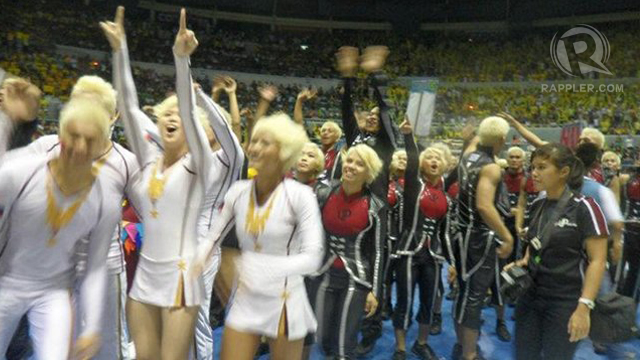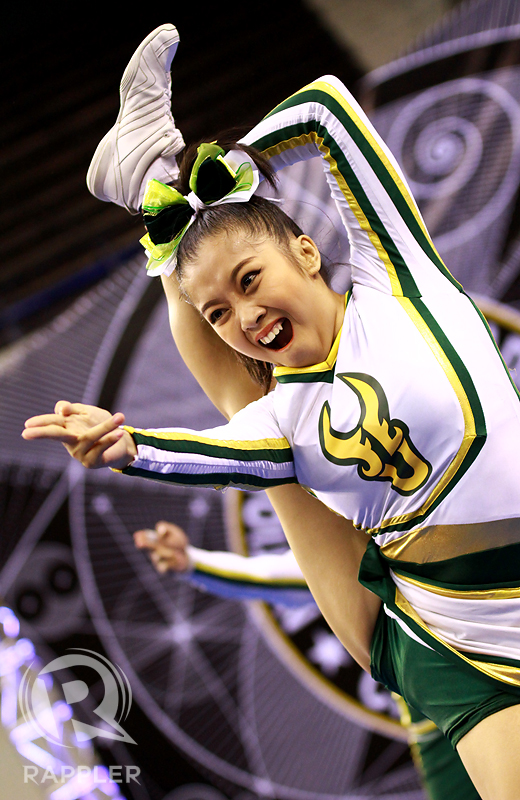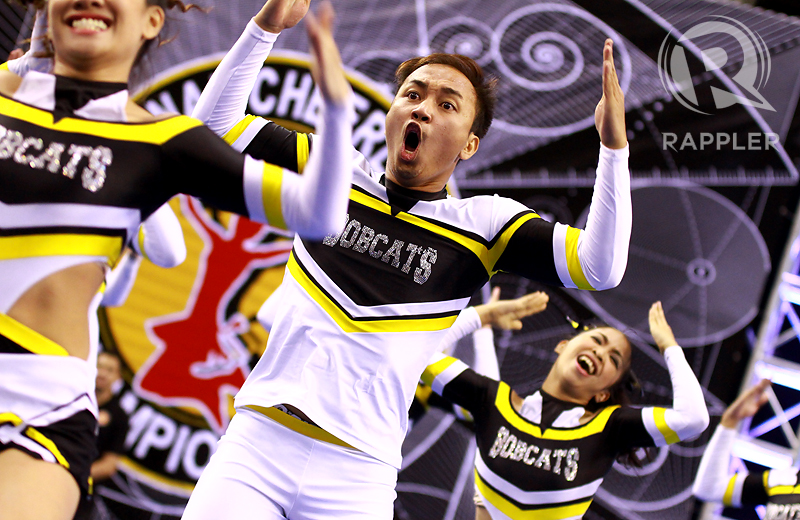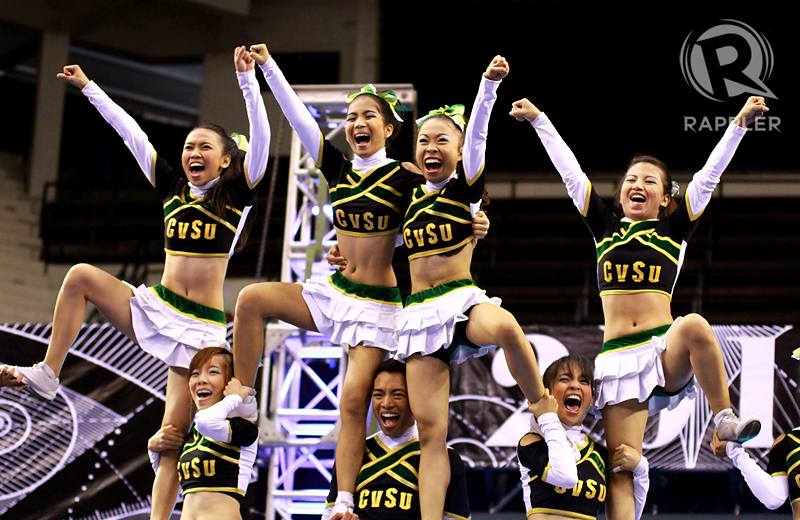SUMMARY
This is AI generated summarization, which may have errors. For context, always refer to the full article.
MANILA, Philippines — If there is one UAAP event that can pride itself in beating the attendance and hype of even an Ateneo-La Salle matchup, it is the UAAP Cheerdance Competition.
For many years now, the annual tilt has rocked the Araneta Coliseum with crowds of upwards of 20,000, with hundreds of thousands more, glued to the TV in their homes, eagerly anticipating what routines storied teams like the University of the Philippines (UP) Pep Squad and the University of Santo Tomas (UST) Salinggawi Dance Troupe will put on display.
Rivalries
Out of the UAAP Cheerdance Competition arose rivalries like the UP-UST battle, what with the 2 giant schools combining for 15 of the 17 titles won since the contest’s inception in 1994.

The emergence of the Far Eastern University Cheering Squad and the De La Salle University Animo Squad has also added flavor to what can be considered as the most awaited non-basketball event of the UAAP calendar.
Last season alone, the cheerdance competition netted 23,448 fans at the Big Dome, making it the 5th-most attended indoor sporting event in the world in 2011, beating out crowds in Game 6 of the NBA Finals (20,003), Game 2 of the UAAP Men’s Basketball Championship Series (18,423) and Game 7 of the PBA Governor’s Cup Finals (16,928).
This just goes to show how the cheerdance contest has gone from just another side event to what appeals to most as the “cheerleading authority in the country.”
It is why the UP Pep Squad was seemingly deified after winning their 4th crown in 6 years last September. Add to that the fact that the Diliman-based crew placed 3rd in the Cheerleading World Championships in Hong Kong 2 months after, strengthening the UAAP Cheerdance Competition’s mettle as the Philippines’ primary cheerleading tilt.
National Cheerleading Championship
Enter the National Cheerleading Championship (NCC), a contest that brands itself as the first and only cheerleading competition in the country that uses American rules and regulations. Since its foundation in 2006, the NCC has been at the forefront of promoting cheerleading in the country.
JR David, NCC director and manager of the Philippine cheerleading team sent to competitions under the International Cheer Union, tells Rappler in an interview that cheerleading is a “progressive sport.”
“We’re trying to promote it as a sport,” David says, noting that cheerleading hasn’t been treated as a sport but rather a side activity that spices up games. “There are scientific studies that show that it is one of the most dangerous sports but unfortunately, it hasn’t been recognized as an Olympic sport.”
David hopes that over the next decade or so, cheerleading will get enough traction and morph into an Olympic competition.
No popularity contest
Popularity-wise, however, the NCC is easily trumped by the UAAP Cheerdance Competition, even though the former is participated in by more schools and has supposedly the backing of colleges and universities in Luzon, Visayas and Mindanao.
A look at the 2 groups’ social media following bares the obvious: the NCC has 16,430 “fans” as of posting time, a figure easily dwarfed by an unofficial UAAP Cheerdance Competition page that has 107,713 “likes.”
Additionally, the NCC, after opening its first season at the Araneta Coliseum, has been held in smaller arenas ever since with the 2012 edition conducted at the Ynares Sports Arena in Pasig City. And while the UAAP has been widely covered by all forms of media, the NCC has been broadcast live only once, in 2010.
CCP domination; UP Pep snub
The Central Colleges of the Philippines (CCP) Bobcats have been dominant in the NCC by coming up with simple routines that are marked by uncanny synchronization and almost flawless execution. The Sta. Mesa-based group has won 4 of the last 6 NCC crowns and was out of the Top 3 only once.
The UP Pep Squad, unarguably the most popular cheerleading team in the country today, has not joined the NCC for the past 5 years after placing 2nd to CCP in 2007 even as the NCC doesn’t enjoy universal participation among UAAP members.
Ironically, it was UP that won the inaugural NCC title, scoring 262 points (the lowest by a champion) in beating CCP (252.5) and UPHSD (248) in 2006.
Apples and oranges
Judging the two tilts, though, is like comparing apples and oranges, as cheerdance and cheerleading are two different forms of art borne out of the desire to entertain fans and inspire players through one thing: cheering.
“Cheerdance competition is cheerleading and a dance,” says decorated coach Rhufa Rosario, who handles both the UAAP’s DLSU Animo Squad and the NCAA’s University of Perpetual Help System Perp Squad. “It focuses more on dance and different kinds of themes and props.”
On the other hand, the multi-titled mentor notes, cheerleading is more of a sport. It takes dance as just one of the 5 basic elements of cheerleading and the challenge is to balance all 5, including tumbling, stunts, pyramids and tosses, in a routine.
Rosario knows it all too well, having steered the Perp Squad to 6 championships in the NCAA Cheerleading Competition and the Animo Squad to a second-place finish in last year’s UAAP battle. His UPHSD team has also consistently finished in the Top 3 of the NCAA, winning first in 2009, bagging 2nd once and bringing home the bronze trophy 4 times.
“In a cheerdance competition, we do basic stunts and tosses,” he adds. “But if you have the best dance and a nice gimmick, you will win.”
Rosario quips that the Salinggawi Dance Troupe may not exactly have the best athletes, but almost every time comes up with a flawless dance routine — the reason why the UST crew is considered a perennial contender.
For David, cheerleading is more technical and cheerdance more artistic.
“It’s thematic,” he says of cheerdancing. “The team decides on what costume to wear. You can go ati-atihan (tribal). You can go Chinese. The use of props is more obvious but there’s still the element of cheer.”
In cheerleading, meanwhile, scoring points needs more of a team effort to synchronize and complete stunts, tosses and pyramids in unison rather than flashing an ultra-talented athlete doing 10 consecutive backflips alone.
“Pag may nag-tumbling nang sabay-sabay, same yung form at yung technique, mas okay yun kesa sa dalawa lang na gumawa pero mas complicated (If a group does synchronized tumbling, has the same form and technique, that’s better than 2 people who do a more complicated tumble),” David adds.
Cheerdance harder?
Asked which is harder to prepare, Rosario says that a cheerdance routine definitely requires a lot more work — and imagination — than cheerleading pieces.
“For me as a coach and a choreographer, it entails more hardships,” he says in jest. “You need to have a theme kasi. For example, sa La Salle, paano mo ipapalabas yung archer? Last year, we came up with an idea na ‘archer in the forest’ but there are so many options kaya ang hirap talaga.”
The ‘archer in the forest’ theme was great enough for the UAAP panel to notice the Animo Squad’s rise and award them the 1st runner-up plum, the first podium finish for La Salle in 13 years, despite an in-performance injury to one of its dancers.
It was Rosario’s first venture into the UAAP after lording it over in the NCAA, where his Perps Squad completed a 3-peat last month and a testament that one can transition from forming a cheerdance routine to designing an award-winning cheerleading piece almost seamlessly.
“It really depends on your forte,” David explains. “If you’re used to cheerdance tapos biglang sabak ka ng cheerleading, mahihirapan ka (then you suddenly shift to cheerleading, you’ll find it difficult). Plus, in the NCAA, all teams get better every year.”
It is important to note however, that whether a fan prefers cheerleading over cheerdance or vice versa, the simple goal of every toss, tumbling or pyramid these athletes complete is one: to cheer for their players and pump up the crowd. – Rappler.com
Add a comment
How does this make you feel?




There are no comments yet. Add your comment to start the conversation.